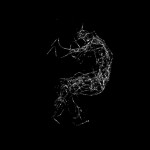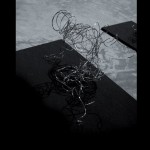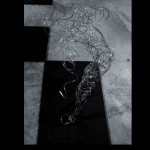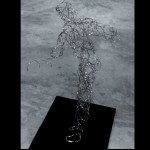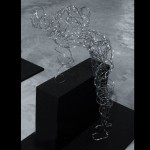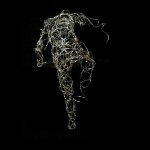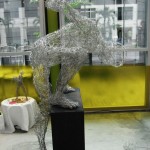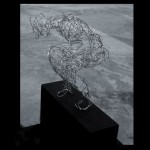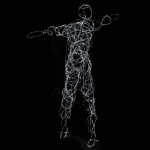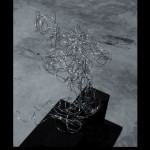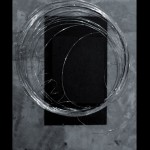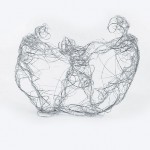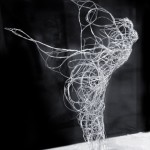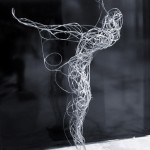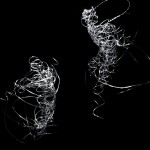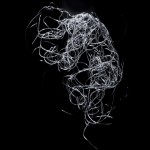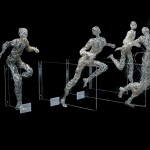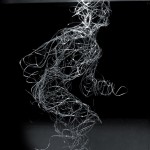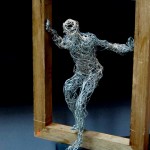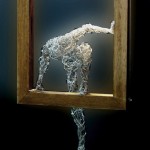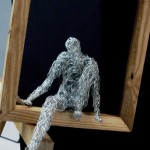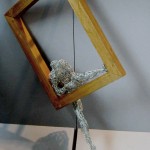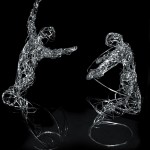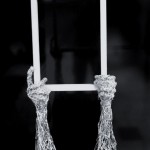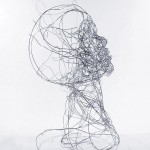Between 2 and 3 二与三之间
Solo Exhibition, Gallery Everson Hotel, 2001
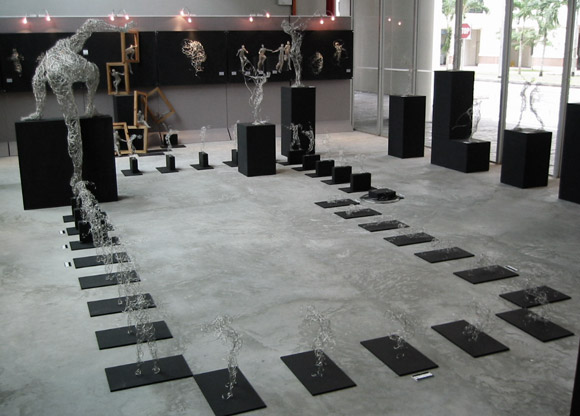
When confronted with a wire sculpture of Victor Tan Wee Tar’s, one is invariably drawn to handling the figure and marveling at the intricate handiwork that has gone into its synthesis. The medium of stainless steel wire, especially when used for figuration, is Victor’s own in Singapore, innovated as a student in the LaSalle-SIA College of the Arts in the mid-90s. The wire is coiled and shaped into human form, beginning first with a loose contouring of the body, head and limbs, then followed by additional filling in and densification which gives muscle to the skeleton. Originally building a figure from thinner wire to thicker strands, Victor’s fingers are now nimble enough to shape a figure directly with wire of a single thickness, using the thinner strands only for a finer touch and to secure segments in a desired posture. The virtuosity of the contouring process is now captured in a series of deft wire sketches in Between 2 and 3, his first solo exhibition in Singapore.
Visitors to Victor’s studio in Telok Kurau have often commented on the dynamism of his incomplete figures; they possess a distinct character that would change if the figures were filled in. This has encouraged him to mount the current exhibition, which explores using wire to sketch out figures in motion, or at rest. A pencil sketch on paper usually conveys a sense of immediacy with ease because strokes can be applied quickly, following the rapid motion of the artist’s hand. Is it possible to convey a similar vibrancy and essence using a solid medium such as sculpture? Between 2 and 3 presents Victor’s investigations into this intriguing question.
His chosen medium, wire, affords him one advantage that bronze-casting or ceramic work is unable to, that of a particular quality of line. Line is able to give a feeling of movement, and of flow. There is an elusive energy in a line sketch that is difficult to emulate in a solid format. In sculpture, wire can best capture these qualities of line. Wire can shape the outline of a human torso with precision and speed, particularly in the hands of someone as skilled as Victor. Wire coiling can also fill in a figure outline, much as the application of several pencil marks shades in and provides volume to a flat contour. This ambiguity between techniques which are more commonly applied to one medium than another provides the uncertainty as to whether the work is more of a two-dimensional (2D) than three-dimensional (3D) nature, or otherwise somewhere in between – Between 2 and 3, so to speak.
The economy of use of wire in this current series reinforces the idea of a sketch. Occasionally the front contours of the figure will be more defined than the back, giving the impression of a man rushing forward. The idea of a man in motion is effectively created, and strengthened by the arrangement of several of the figures in succession (The Awareness of Being), as in stop-action photography or animation storyboards. Figures in dynamic motion are contrasted by other figures lying prostrate. These prone figures explore the aesthetics of the horizontal line, and their stagnancy acts as a counterpoint to the fleeting impermanence of other more vertically-oriented running forms. Again an impression of ‘between’-ness is created, here between motion and stillness. Being caught between two states is a recurrent theme with Victor who exhibited a large sculpture entitled ‘Between’ in the exhibition Provocative Things at Sculpture Square (1999). There, a life-sized wire figure emerged from a suspended wooden doorway, fixed yet hanging, tentatively testing the external environment, but not entirely divested of his background (see the maquettes present in this exhibition). The artist’s statement for the work suggests a metaphor for human existence being in a continual state of flux and uncertainty, but that we can live for the moment and dare to determine our own directions.
What background has the artist emerged from? In his diploma studies at LaSalle-SIA College of the Arts, Victor gravitated naturally towards the 3D media. Partially sighted due to optic neuritis, the tactility of sculpture has allowed him to shape his expressions into concrete form. Although a ceramics major, Victor had already begun experimenting with wire in his first year of studies (1995), starting with less well-defined creations, but evolving quickly to discrete figures. Using his own body as a basis for obtaining human proportions, the vast bulk of his output is in the male form. The early work focused on sitting and kneeling figures, then as he became more adept, Victor’s figures found their feet, exploring balance and posture in increasingly dramatic compositions, and in the current exhibition, movement. For wire, he has utilized galvanized steel, copper, brass, and now, stainless steel, which gives his figures a shiny, flexible resilience.
After completing his diploma, Victor spent an additional year to obtain his Bachelor of Arts in Fine Arts (Sculpture) from the RMIT, and in 1999, became the first Singaporean to win the Commonwealth Arts and Craft Award, leading to a 6-month residency in London with the sculptor Bryan Ellery. His stint abroad did not change his technique (media such as video and performance remain distant to him) as much as broaden his perspective on life in general. Observing his host’s activities (which included considerable time out of the studio meeting people and arranging projects), Victor has strengthened his resolve to be more interactive socially and pro-active in the management of his career. He discovered that attitudes in the London art world were not unlike that at home, with differing hierarchies of artists, collectors and dealers, just much more diverse and massive in scale.
Victor finds inspiration from his feelings, his interactions with people, and his beliefs, which are rooted in the Buddhist faith. Meditation has heightened his concentration and state of consciousness, making him acutely aware of the here and now. He does not see his work as particularly Singaporean, a trait shared by several local artists who do not proceed from a strong background of traditional culture, and whose work takes on either an internationalist feel or is of an intensely personal nature. Before losing his sight, Victor had not made any particular study of established three-dimensional artworks, so his creations are all the more precious, referencing not any art historical masterwork but arising from his own internal visions. From his initial explorations of relatively formal postures and stances, more inventive compositions have surfaced which suggest intriguing stories behind each work (the two figures reaching out to touch from the ‘Okay’ series at the Singapore Expo, Between Ideas in this exhibition). For his first solo exhibition Born in Gallery 47, Central London (2000), Victor explored issues of creation, single parenthood and the sculptor as mother to his work, giving rise to figures of babies, and more unusually, pregnant men, and men in the process of labour. Between 2 and 3 sees Victor moving into yet another series of work, and establishing himself as one of the more exciting young artists on the Singapore art scene.
The works in Between 2 and 3 can roughly be grouped into four sections:
The Awareness of Being encapsulates the essence of the exhibition. A succession of wire figures presents a man waking up, arising from his slumber, standing up, reaching a wall, and surmounting the barrier to experience an ecstatic burst of wind. The idea of movement is adeptly conveyed using a series of figures, akin to the process of animation. However Victor uses 3D sculptures, not 2D drawings in series, and the movement is captured through wire, not paints nor pen, heightening the duality between 2D and 3D modes of expression.
Each figure also represents a crystallized instant in a series of actions. Victor has attended a number of meditation retreats in Thailand, Myanmar and Sri Lanka, and has learnt that a heightened consciousness can be achieved not just in a static meditative state, but by being deliberately aware of one’s motions. By repeating the words ‘rising – rising – rising’ and ‘standing – standing – standing’ as one goes through the postures, one can also focus to achieve inner calm.
Examining the prone Awakening and Rising figures, one notices freer form and line work, as compared to the Standing series, where the figures on two legs require balance (not easily achievable) to be upright. This is accomplished by subtle strengthening of the joints with wire, a process which tends to give the work a denser appearance. Reaching and Touching describe the approach to the wall; this then leads to the figure Climbing, which includes the larger-than-life dramatic centerpiece to the series. Balancing, Experiencing, Ecstasy and Gratitude phases beautifully capture the figure negotiating its precarious position, then exulting in its achievement. The series can be viewed as a metaphor for artistic creation as one awakens to an idea, familiarizes oneself with it, and overcomes hurdles to attain mastery and joyous fulfillment, until the cycle begins again with the next new idea (represented by a wire mass in The New Beginning).
Dancers in the Wind is a series that segues directly from the joy at the Ecstasy segment of The Awareness of Being. During the course of a day, Victor’s room at the top of Telok Kurau Studios receives a delightfully cooling breeze. At such times, the artist simply stops work to savour the wind, closes his eyes, pretends he is flying off and breaks into a blissful dance. The series captures the movement of air over a dancer’s outstretched arms, and the heavenly experience not inappropriately suggests an ethereal, angelic form.
Snapshots describe the actions, several of running men, captured freeze-frame and attached to a background of black wooden boards. The beauty of the line work is apparent in several wire sketches of varying sizes, again with the ambiguity of a 3D medium set on a flat 2D format. Motion is a large accomplished running figure, which is contrasted with a less well-defined, subtler, near-foetal depiction of Stillness. The Wind in my Hair, the Clouds at my Feet portrays two freely twirling spirits as they waft in the breeze, trailing a substantial flurry of wire coils. The maquettes for ‘Between’; in the exhibition Provocative Things at Sculpture Square (1999) are displayed as a snapshot of the past to show Victor’s continuing preoccupation with the theme. These depict a figure in various stages of finding its way through a frame. Note the appearance in maquette of the large Climbing figure in The Awareness of Being which was originally planned for the same 1999 show. Many other snapshots belong to the Running series, with an older set of four well-defined, dense figures mounted on acrylic in order to portray sequential racing postures, and a new set of adept wire sketches of torsos in an array of running postures.
Free-standing forms on pedestals continue on the theme of running men with Breasting the Tape and Victory. One of the more important pieces of the exhibition, Between Ideas depicts the artist caught in a dilemma between two competing directions in his mind, represented as two divergent figures. Finally, Victor presents a Self-Portrait in the sketch-style of Between 2 and 3. The bust of himself uses free-form contouring to shape the neck and head, but this coalesces into a denser mask-like face, enigmatic, mysterious, haunting, with no hint, save of the object itself, of the genius behind Victor’s talent.
Written by : Dr Pwee Keng Hock 1/8/2001, based on a conversation with Victor on 27/7/2001
Publications
2001 Arts Magazine – Review (PDF – 1.2MB)
2001 Lianhezaobao – Review (PDF – 1.2MB)
2001 Shin Nichi Ho (PDF – 172kb)
2001 Straits Times – His Art Sees All (PDF – 139kb)
2001 Today (PDF – 147kb)
个展,埃弗森酒店画廊,2001

当面对陈为达 (Victor Tan Wee Tar) 的不锈钢铁线雕塑时,人们总是会被吸引,想触摸它,并惊叹于其合成过程中复杂的手工制作。不锈钢丝这一媒介,尤其是用于造型时,是 陈为达在新加坡自己发明的,是 90 年代中期拉萨尔-新航艺术学院的学生时发明的。将不锈钢铁线盘绕成人体形状,首先对身体、头部和四肢进行松散的轮廓,然后进行额外的填充和致密化,从而为骨骼提供肌肉。陈为达最初是用较细的金属丝建造一个较粗的线,现在他的手指足够灵活,可以直接用单一粗细的线塑造一个人物,使用较细的线只是为了获得更精细的触感,并将各个部分固定在所需的姿势。他在新加坡的首次个展《Between 2 and 3》中一系列灵巧的钢丝草图展现了轮廓过程的精湛技艺。
参观陈为达位于直落古楼工作室的参观者经常评论他不完整的人物的活力;它们具有独特的特征,如果人物被填充,这种特征就会改变。这鼓励他举办当前的展览,探索使用电线勾画出运动或静止的人物。纸上的铅笔素描通常可以轻松地传达一种即时感,因为可以跟随艺术家手部的快速运动快速应用笔触。是否有可能使用雕塑等固体媒介来传达类似的活力和本质?第 2 章和第 3 章介绍了陈为达对这个有趣问题的调查。
他选择的媒介——不锈钢铁线,为他提供了青铜铸造或陶瓷作品无法比拟的优势,即特殊的线条质量。线条能够给人一种律动、流动的感觉。线条草图中有一种难以捉摸的能量,很难以实体格式来模拟。在雕塑中,线材最能体现线条的这些品质。钢丝可以精确而快速地塑造人体躯干的轮廓,尤其是在像陈为达这样熟练的人手中。线圈也可以填充图形轮廓,就像使用几个铅笔标记阴影并为平坦轮廓提供体积一样。一种媒材比另一种媒材更常应用的技术之间的这种模糊性提供了不确定性,即作品是否更多地具有平面 (2D) 性质而不是立体 (3D) 性质,或者介于 2 和 3 之间。 3、可以这么说。
当前系列中不锈钢铁线的使用经济性加类似一张草图。有时人物正面轮廓会比背面轮廓更分明,给人一种奋勇向前的印象。一个在行动的人有效地被创造出来,并通过几个人物的连续排列(存在的意识)得到加强,就像在定格动作摄影或动画故事板中一样。动态运动的人物与其他平躺的人物形成鲜明对比。这些俯卧的人物探索了水平线的美感,它们的停滞与其他更垂直的跑步形式的短暂无常形成了对比。在这里,动静与静止之间再次产生了一种“介于两者之间”的印象。夹在两种状态之间是陈为达反复出现的主题,他在雕塑广场的挑衅性事物展览(1999)中展出了一件题为“之间”的大型雕塑。在那里,一个真人大小的不锈钢铁线人物从悬挂的木门中出现,固定但悬挂着,试探性地测试外部环境,但并没有完全脱离他的背景(参见本次展览中的模型)。艺术家对这件作品的表述隐喻了人类的存在处于不断变化和不确定的状态,但我们可以活在当下,并敢于确定自己的方向。
这位艺术家是从什么样的背景发展出来的呢?在就读拉萨尔艺术学院的文凭课程时,陈为达自然而然地被立体媒材所吸引。由于视神经炎而导致部分失明,雕塑的触觉使他能够将自己的表情塑造成具体的形式。虽然陈为达主修陶瓷,但他在学习的第一年(1995 年)就已经开始尝试不锈钢铁线,从不太明确的创作开始,但很快发展到离散的数字。他以自己的身体为基础来获得人体比例,大部分作品都是男性形态。早期的作品集中于坐着和跪着的人物,然后随着他变得更加熟练,陈为达的人物找到了自己的立足点,在日益戏剧化的构图以及当前的展览中探索平衡和姿势。对于铁线,他使用了镀锌钢、铜、黄铜,现在又使用了不锈钢,这使他的人物具有闪亮、灵活的弹性。
完成文凭课程后,陈为达又花了一年时间从 RMIT 获得美术(雕塑)学士学位,并于 1999 年成为第一位赢得英联邦艺术与工艺奖的新加坡人,并获得了为期 6 个月的驻留资格在伦敦与雕塑家布莱恩·埃勒里 (Bryan Ellery) 一起。他在国外的经历并没有改变他的技术(视频和表演等媒体对他来说仍然很遥远),反而拓宽了他对生活的看法。通过观察东道主的活动(包括在工作室外与人会面和安排项目的大量时间),陈为达坚定了他在社交方面更加互动和积极主动地管理自己职业生涯的决心。他发现伦敦艺术界的态度与国内没有什么不同,艺术家、收藏家和经销商的等级不同,只是更加多样化和规模更大。
陈为达从他的感受、与人的互动以及植根于佛教信仰的信仰中找到灵感。冥想提高了他的注意力和意识状态,使他敏锐地意识到此时此地。他并不认为自己的作品特别具有新加坡特色,这是几位本地艺术家所共有的特征,他们没有深厚的传统文化背景,他们的作品要么带有国际主义的感觉,要么具有强烈的个人色彩。在失明之前,陈为达并没有对已有的三维艺术进行过专门的研究,因此他的创作更显得弥足珍贵,并非参考任何艺术史的杰作,而是源于他自己的内心想象。从他最初对相对正式的姿势和立场的探索开始,更多创造性的构图浮出水面,这些构图暗示了每件作品背后有趣的故事(两个人物在新加坡博览会的“Okay”系列中伸出手来触摸,在本次展览的“想法之间”)。在他的第一次个展“诞生于伦敦市中心 47 号画廊”(Born in Gallery 47, Central London)(2000 年)中,陈为达探讨了创作、单亲身份和雕塑家作为其作品的母亲等问题,塑造了婴儿的形象,更不寻常的是,怀孕的男人和男人的形象。劳动的过程。在《2》和《3》之间,Victor 开始了另一系列的作品,并将自己确立为新加坡艺术界最令人兴奋的年轻艺术家之一。
《Between 2 and 3》的作品大致可分为四部分:
存在意识概括了展览的精髓。一连串的不锈钢铁线人物描绘了一个男人从睡梦中醒来,站起来,到达墙壁,然后越过障碍物,体验一阵狂喜的风。运动的概念是通过一系列人物巧妙地传达的,类似于动画的过程。然而,陈为达使用立体雕塑,而不是串联的平面绘图,并且通过铁线而不是油漆或笔来捕捉运动,从而增强了平面和立体表达模式之间的二元性。
每个人物也代表了一系列动作中的一个具体瞬间。陈为达参加了泰国、缅甸和斯里兰卡的多次冥想静修,并了解到,提高意识不仅可以在静态冥想状态下实现,还可以通过刻意注意自己的动作来实现。通过在练习姿势时重复“起——起——起”和“站——站——站”这两个词,人们也可以集中注意力来获得内心的平静。
审视俯卧的“觉醒”和“崛起”人物,人们会发现与“站立”系列相比,其形式和线条更加自由,在“站立”系列中,两条腿上的人物需要平衡(不容易实现)才能直立。这是通过用金属丝对接头进行微妙的强化来实现的,这一过程往往会使作品具有更致密的外观。到达和触摸描述了接近墙壁的过程;接下来就是人物《攀登》,其中包括该系列具有传奇色彩的戏剧性核心作品。平衡、体验、狂喜和感恩阶段完美地捕捉到了人物如何应对不稳定的处境,然后为自己的成就而欣喜若狂。该系列可以被视为艺术创作的隐喻,当一个人唤醒一个想法,熟悉它,并克服障碍以获得掌握和快乐的满足,直到循环再次开始下一个新想法(由线团代表)新的开始)。
风中舞者是一个直接从《存在的意识》中狂喜部分的欢乐延续下来的系列。在一天的时间里,陈为达位于直落古楼工作室顶层的房间都会感受到凉爽的微风。每当这时,艺术家就会停下手中的工作,享受微风,闭上眼睛,假装飞走,跳起一段幸福的舞蹈。该系列捕捉了舞者张开双臂的空气流动,这种天堂般的体验恰如其分地暗示了一种空灵、天使般的形式。
快照描述了几个跑步者的动作,捕捉到了定格画面并附在黑色木板的背景上。线条之美在几张不同尺寸的线草图中显而易见,同样带有在平面 2D 格式上设置的 3D 媒体的模糊性。动静是一个大型的奔跑人物,与静止的不太明确、更微妙、近乎胎儿的描绘形成鲜明对比。 《发间的风,脚下的云》描绘了两个自由旋转的灵魂,在微风中飘荡,拖曳着大量的线圈。 “Between”的模型;在展览《雕塑广场的挑衅性事物》(Provocative Things at Sculpture Square,1999)中,以过去的快照形式展示了陈为达对这一主题的持续关注。这些描绘了一个人物在画面中寻找出路的各个阶段。请注意《存在的意识》中大型攀爬人物模型的出现,该人物最初计划在 1999 年的同一场展览中亮相。许多其他快照都属于跑步系列,其中一组旧的四个轮廓清晰、密集的人物安装在亚克力上,以描绘连续的赛车姿势,而一组新的熟练的线草图则展示了一系列跑步姿势的躯干。
基座上的独立形式继续以“Breasting the Tape”和“Victory”的跑步者为主题。展览中最重要的作品之一《思想之间》描绘了艺术家在他的头脑中陷入两个相互竞争的方向之间的困境,并以两个不同的人物来表现。最后,陈为达以《2与3之间》的素描风格呈现了一幅自画像。他的半身像使用自由形状的轮廓来塑造颈部和头部,但这又融合成一张更密集的面具般的脸,神秘莫测,神秘莫测,令人难以忘怀,除了物体本身之外,没有任何暗示,维克多才华背后的天才。
Written by : Dr Pwee Keng Hock 1/8/2001, based on a conversation with Victor on 27/7/2001
Publications
2001 Arts Magazine – Review (PDF – 1.2MB)
2001 Lianhezaobao – Review (PDF – 1.2MB)
2001 Shin Nichi Ho (PDF – 172kb)
2001 Straits Times – His Art Sees All (PDF – 139kb)
2001 Today (PDF – 147kb)

